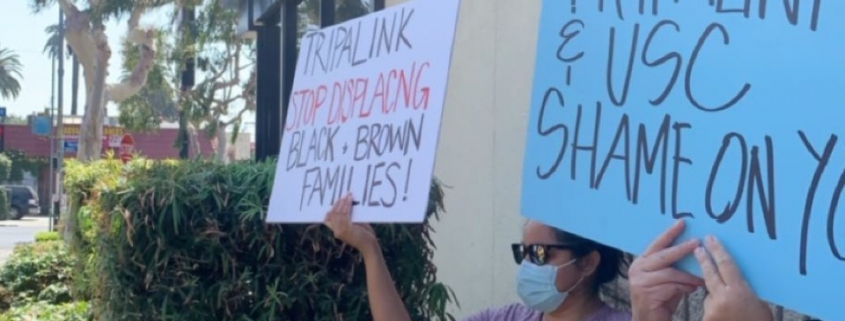Protest sheds light on local gentrification

Waving signs that read “Tripalink & USC Shame on You” and chanting “no more displacement,” activists, local residents and USC students gathered outside Tripalink student housing offices near USC’s campus on June 3, protesting rising rental costs, unfair construction practices and new housing that is rapidly changing the landscape of the area and leading to the displacement of longtime South Central Los Angeles residents.
The protest highlighted enduring issues for the neighborhood surrounding the University: rising rents, gentrification and the disparity between a largely white, wealthy student body and a predominately person of color, working-class surrounding community.
Tripalink, a housing company based in L.A. that markets specifically to college students and young professionals, has expanded rapidly across both L.A. and the United States since it was founded in 2016, targeting areas where universities can expand into surrounding communities.
“[Protesters] just want to start exposing what [Tripalink is] doing to our community,” said Sergio Vargas, an organizer for ACCE, a housing advocacy organization. “[Protesters] were there giving testimonies of what they’re going through at this moment and what this company is inflicting upon them, basically talking about the displacement that it creates. Long term homeowners, they’re displacing these folks. The neighborhood is changing very rapidly for the community, so they want to put a stop to it.”
Housing near USC costs around $1,000 per bed, even in shared rooms, and can cost over $1,500. According to RENTcafé, a housing rental website, the average rental cost in University Park is $4,146, the most expensive in all of L.A.. Historic South Central, which encompasses parts of the neighborhood around USC, has the second highest average rental cost of $4,094.
Vargas said that while he is supportive of building more housing, Tripalink’s apartments are too expensive for many of the longtime residents. If Tripalink housing were more affordable, he would want them to build more buildings so that “our folks can live in [them], and they can pay those rents.”
“The prices of these apartments are just way above what people can afford,” Vargas said. “If they’re going to build, we want it to be 50% affordable housing so the folks in the community can live in there too.”
The problem, Vargas said, is not limited to South Central, and Tripalink’s model of investing into low income communities with universities could spread.
“If a company like Tripalink is successful at creating this model, there will be way more other companies like them trying to come into any other surrounding low income area where there’s a university,” Vargas said.
In a statement to the Daily Trojan, the Tripalink Marketing and PR Manager said the company is committed to providing economical housing and is “proactively communicating with community stakeholders to address these issues.” The representative also said Tripalink has taken action to reduce the impact of construction on the neighborhood.
While the specific conditions of the protest were directed toward Tripalink, Vargas said USC is aware of the situation, as representatives from USC have attended ACCE organizing meetings.
For Vargas, USC has contributed to what he views as a growing problem.
“USC is not doing enough for their students in their own campus, so what we see is [the University] giving these companies the idea for them to go out and gentrify, and then pretty much displace folks, so they can house more students in the surrounding area,” Vargas said.
In a statement to the Daily Trojan, the University said, “The [University] has no affiliation with Tripalink. We will continue to work with our partners in the city of Los Angeles and in our community through a City Council task force that includes Neighborhood Councils and community leaders. This public process is designed to help maintain the neighborhood’s integrity.”
Kelli Lloyd, a resident of City Council District 8 and a member of ACCE — the district in which USC is located — was at the protest because she said residents are being harassed into selling their homes and enduring unfair construction within the community. Lloyd lives in the Crenshaw District, about three miles from USC. Though she said she has not been directly affected by Tripalink, there have been similar housing trends close to where she lives — that have also been affected by USC’s spread into the surrounding community — where residents are being evicted to get them out of rent controlled apartments.
“Rents are sky high. The community has changed. While it’s more diverse, the people that are coming in don’t favor the diversity that’s here,” Lloyd said. “So it’s pretty rough to be in a community where you’re comfortable, and the people who are coming in don’t have the same sense of community.”
Isa Johnson, a rising sophomore majoring in journalism, joined the protest after hearing a commotion from her room through an open window. Running out of her apartment in her red pajamas with her keys in hand, Johnson said she immediately felt connected to the protesters after seeing that many of their signs were in Spanish.
“I thought it was just ironic that I’ve been studying all these ways that there’s all of these race gaps and wealth gaps and racial disparities, and I’ve been learning about this from this institution that is doing those things,” Johnson said.

